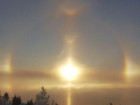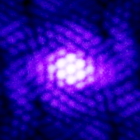|
Science and Astronomy Questions
|
|
| midtskogen | Date: Saturday, 13.08.2016, 19:49 | Message # 706 |
 Star Engineer
Group: Users
 Norway
Norway
Messages: 1674
Status: Offline
| Quote steeljaw354 (  ) So what would and antimatter planet look like?
Exactly like a normal planet.
NIL DIFFICILE VOLENTI

|
| |
| |
| steeljaw354 | Date: Saturday, 13.08.2016, 19:54 | Message # 707 |
 World Builder
Group: Users
 Pirate
Pirate
Messages: 862
Status: Offline
| What would happen if a matter 2km asteroid hit an earth sized antimatter planet?
Edited by steeljaw354 - Saturday, 13.08.2016, 20:09 |
| |
| |
| JackDole | Date: Saturday, 13.08.2016, 20:29 | Message # 708 |
 Star Engineer
Group: Local Moderators
 Germany
Germany
Messages: 1742
Status: Offline
| If I have not miscalculated, is the explosion ca, 3:35 trillion times more powerful than the atomic bomb of Hiroshima.
Don't forget to look here.

|
| |
| |
| steeljaw354 | Date: Saturday, 13.08.2016, 20:32 | Message # 709 |
 World Builder
Group: Users
 Pirate
Pirate
Messages: 862
Status: Offline
| Would it destroy the antimatter planet?
|
| |
| |
| midtskogen | Date: Saturday, 13.08.2016, 20:38 | Message # 710 |
 Star Engineer
Group: Users
 Norway
Norway
Messages: 1674
Status: Offline
| Quote steeljaw354 (  ) What would happen if a matter 2km asteroid hit an earth sized antimatter planet?
Quick calculations tell me that it would release the same amount of energy that the sun outputs in a day.
Quote JackDole (  ) If I have not miscalculated, is the explosion ca, 3:35 trillion times more powerful than the atomic bomb of Hiroshima.
You mean a European trillion, 10¹⁸?
Quote steeljaw354 (  ) Would it destroy the antimatter planet?
The effect would roughly be like this:

(in reality there would be far too much light and radiation to make out anything)
NIL DIFFICILE VOLENTI

Edited by midtskogen - Saturday, 13.08.2016, 20:40 |
| |
| |
| JackDole | Date: Saturday, 13.08.2016, 20:49 | Message # 711 |
 Star Engineer
Group: Local Moderators
 Germany
Germany
Messages: 1742
Status: Offline
| I mean 3.36 * 10 ^ 12.
Maybe it's only half as much, ie 1,675 trillion times the Hiroshima bomb. Exactly I do not know that, I'm not a physicist.
But you are right.
I miscalculated.
It should be 2.234 * 10 ^ 17.
Don't forget to look here.

Edited by JackDole - Saturday, 13.08.2016, 20:57 |
| |
| |
| midtskogen | Date: Saturday, 13.08.2016, 21:10 | Message # 712 |
 Star Engineer
Group: Users
 Norway
Norway
Messages: 1674
Status: Offline
| My calculations went like this (more accurate now):
2 km asteroid, 3g/cm³ = 12*10^12 kg. This mass, plus an equivalent planet mass, will turn into energy. so we get 2*12*10^12 * (0.3*10^9)² = 2.3 * 10^30J.
The gravitational binding of Earth is 2*10^32J. So the planet would be completely destroyed, but would condense again.
NIL DIFFICILE VOLENTI

Edited by midtskogen - Saturday, 13.08.2016, 21:11 |
| |
| |
| JackDole | Date: Saturday, 13.08.2016, 21:46 | Message # 713 |
 Star Engineer
Group: Local Moderators
 Germany
Germany
Messages: 1742
Status: Offline
| My calculation is:
V = 4/3 * pi * 200 000 cm = 3.35103216382911278769e16 cm3
I have taken 5 g / cm3
This gives 1.67551608191455639385e17 g.
As far as I know, in the explosion of the bomb 1.5 g mass were converted into energy.
So:
1.67551608191455639385e17 / 1.5 = 1.11701072127637092923e17.
1.11701072127637092923e17 * 2 = 2.23402144255274185846e17 Hiroshima bombs.
Don't forget to look here.

|
| |
| |
| steeljaw354 | Date: Saturday, 13.08.2016, 22:16 | Message # 714 |
 World Builder
Group: Users
 Pirate
Pirate
Messages: 862
Status: Offline
| What is the biggest a terrestrial planet could theoretically be?
|
| |
| |
| midtskogen | Date: Saturday, 13.08.2016, 22:22 | Message # 715 |
 Star Engineer
Group: Users
 Norway
Norway
Messages: 1674
Status: Offline
| Kepler 10c is thought to be about 17 Earth masses.
NIL DIFFICILE VOLENTI

|
| |
| |
| steeljaw354 | Date: Saturday, 13.08.2016, 22:25 | Message # 716 |
 World Builder
Group: Users
 Pirate
Pirate
Messages: 862
Status: Offline
| How do they know it's not an ice giant?
|
| |
| |
| Watsisname | Date: Saturday, 13.08.2016, 22:51 | Message # 717 |
 Galaxy Architect
Group: Global Moderators
 United States
United States
Messages: 2613
Status: Offline
| Quote midtskogen (  ) That is, could "matter" in "dark matter" be misleading in the sense that the only thing it shares with ordinary matter is that it influences the geometry of the universe and other not yet discovered properties set it much apart from ordinary matter, including that we can't detect it in the ways we think?
Yeah, I think that could be true. We generally think of it as 'matter' because we think of it as particles, because it collapses to form structure. Those particles may be very different from the regular matter we know about, though we know at least some of the properties they must have.
But I could also imagine, maybe, that dark matter is not particles at all. Maybe it's a fluid, or a scalar field, or something really weird and unlike anything we've seen before. I don't know how to describe how those would work in any great detail, but such models do exist.
Quote steeljaw354 (  ) Could dark matter stars and planets exist? Could antimatter stars and planets exist?
Midtskogen's answer is spot on. For stars to form from clouds of gas and dust, the particles must cool and collapse gravitationally. But that causes the particles to heat up, so they must be able to radiate that energy away to continue the collapse. Eventually, the opacity of the cloud becomes so high that it heats up anyway, and you get a star.
Dark matter can't radiate (if it did, we would see it), so it can't collapse to form structures on the scales of stars and planets.
Antimatter stars and planets could exist, but we don't think so. There's not much antimatter out there. If there was, we'd see radiation from its annihilation with regular matter.
Quote steeljaw354 (  ) What would happen if a matter 2km asteroid hit an earth sized antimatter planet?
As an independent math check, I get:

If density is 3g/m3 (about that of rocky asteroids), then this gives 2.3x1030J, per midtskogen's answer.
Quote steeljaw354 (  ) How do they know it's not an ice giant?
From its density: about 7g/cm3, which is even greater than Earth's. Ice giants have densities more like one or two g/cm3.

|
| |
| |
| midtskogen | Date: Saturday, 13.08.2016, 22:53 | Message # 718 |
 Star Engineer
Group: Users
 Norway
Norway
Messages: 1674
Status: Offline
| Quote steeljaw354 (  ) How do they know it's not an ice giant?
Because of its density. To calculate the density, you need to know the radius and mass of the planet. The radius can be deduced from looking at the light slopes of the star when the planet transits. The mass can be calculated from the Doppler shift of the star.
Added: Ninjaed by Watsisname, and steeljaw ninjaed by me. :)
Also, I forgot to mention that we need to know the orbit of the planet.
NIL DIFFICILE VOLENTI

Edited by midtskogen - Saturday, 13.08.2016, 23:06 |
| |
| |
| steeljaw354 | Date: Saturday, 13.08.2016, 22:53 | Message # 719 |
 World Builder
Group: Users
 Pirate
Pirate
Messages: 862
Status: Offline
| Where did they come up with these methods to measure the density?
Edited by steeljaw354 - Saturday, 13.08.2016, 22:57 |
| |
| |
| Watsisname | Date: Saturday, 13.08.2016, 23:07 | Message # 720 |
 Galaxy Architect
Group: Global Moderators
 United States
United States
Messages: 2613
Status: Offline
| Quote steeljaw354 (  ) Where did they come up with these methods to measure the density?
Transit method.
Radial velocity method.
If the planet passes directly in front of its star from our line of sight (what we call transiting), then the amount of light it blocks out (which we see as its host star dimming a bit) depends on the planet's size.
Radial velocity measurements is basically an application of the Doppler effect. The star's gravity pulls on the planet to make it orbit, of course, but the opposite is also true. The planet pulls on its star, so the star wobbles slightly. The speed of this wobble may be only a few meters per second -- like walking pace! But with high sensitivity equipment, we can measure this as a regular shift in the star's spectrum, with the same cycle as the planet's orbit. This tells us the planet's mass and orbital period and distance.
Combining these -- the planet's mass and its size -- tells us its density.
Added: To be a bit more precise, the radial velocity method actually only gives us the planet's minimum mass, because it depends on the inclination of the orbit relative to our line of sight. For instance, if the orbit happens to be face-on to us, then all of the star's wobble is in a plane perpendicular to us, so we don't measure any Doppler shift at all. Whereas if the orbit is edge-on, then we get the full effect, and the measured mass is equal to the true mass. So with radial velocity measurements, we actually report the mass as "Msin(i)", meaning as a function of the unknown inclination angle.
Transiting exoplanets have orbits that are edge-on, so we get their true mass when combined with radial velocity.

|
| |
| |